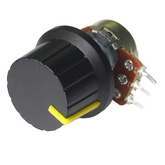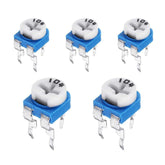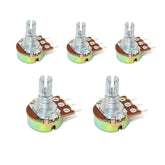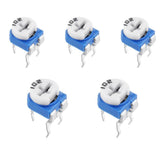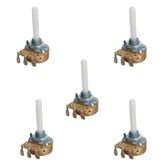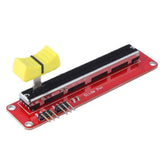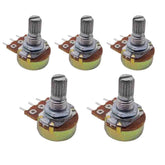What are Variable Resistors?
Summary
Explore the fascinating world of variable resistors in our latest blog! From an insightful introduction to delving into the types of variable resistors, discover how these components work and their diverse applications. Uncover the advantages and disadvantages, while gaining valuable insights through a comparison with fixed resistors. Whether you're a seasoned electronics enthusiast or a curious learner, this blog provides a comprehensive journey through the realm of variable resistors. Don't miss out on understanding the essentials that power countless devices. Read on for an electrifying conclusion that ties it all together!
Introduction
Variable resistors, also known as potentiometers or rheostats, are invaluable components in electronic circuits. Unlike fixed resistors with a constant resistance value, variable resistors allow us to adjust resistance as needed. This variability grants versatility and configurability, enabling optimization and precision in electronic systems. In this article, we will explore variable resistors in-depth, covering their definition, functionality, types, applications, advantages, disadvantages, and comparisons to fixed resistors.
A variable resistor acts as a tunable transducer, converting rotational motion into a changing electrical resistance. This facilitates dynamic current, voltage, or power control in a circuit. Variable resistors empower us to dial-in specific parameter values on-the-fly based on real-time conditions and requirements. Their flexibility and responsiveness underpin many key functions in modern electronics across countless applications.
Simply put, variable resistors provide adjustable analog control. By altering resistance within a circuit, they allow smooth, progressive changes to voltages, currents, and power dissipation. This grants a real-time ability to tweak, optimize, and calibrate electrical behaviors. Variable resistors unlock modulation and dynamism hard to achieve using fixed value components alone.

Types of Variable Resistors
While all variable resistors adjust resistance as they are turned, they differ in wiring configurations and use cases. The two main categories are potentiometers and rheostats.
Potentiometers

Potentiometers contain three terminals - two fixed connections at the resistor ends, and a movable wiper contact that sweeps over the resistive track as it rotates. The wiper position determines how much resistance appears between it and either end terminal. This structure essentially divides the input voltage into adjustable fractions controlled by the wiper angle. Consequently, potentiometers often function as voltage dividers or transducers converting position to voltage. They also facilitate adjustable tapping of signals in electronic circuits.
Rheostats

Rheostats are wired with only two connections - one fixed and one adjustable movable contact. Here, the full resistor value exists between the terminals. Rotating the contact point varies how much resistance is introduced into the attached circuit. Rheostats are commonly used to directly control current flow. However, they can also be incorporated into voltage divider configurations just like potentiometers.
Potentiometers offer simultaneous variable and fixed resistances, whereas rheostats only provide an adjustable single resistance. However, the underlying mechanism of a movable wiper over a resistive track is fundamentally the same. Potentiometers tend to be more versatile, but rheostats excel when only adjustable resistance is required.
Modern variable resistors span a wide spectrum of sizes, power ratings, rotational configurations, mounting options, resistance ranges, linearity, and more. Miniature surface mount chips a few millimeters wide are common, as are industrial or audio units many centimeters in diameter. Rotational angles typically range from 20 degrees up to several full revolutions. Resistance values cover the gamut from ohms to megohms. Prices range from a few cents for simple units to hundreds of dollars for high-performance precision models.
How Variable Resistors Work
Variable resistors function via direct physical alteration of resistive paths by sweeping contacts over tracks of materials exhibiting variable resistivity. When the contact slides toward the low-resistance end of the track, the overall observed resistance drops. Conversely, it increases as the contact moves toward the high-resistance end. This approach produces smooth, progressive adjustments spanning the resistor's full nominal range.
The resistive tracks in quality variable resistors are constructed from firmly compressed circular or rectangular ceramic or plastic blocks with resistive films or conduits embedded in them. Wirewound tracks made by coiling various alloys are also sometimes used, especially for high-power models. Typical resistive elements include conductive composites, cermets, graphite, and Nichrome wire. The wiper contacts are formed from fine spring metal wires tipped with small sliding contacts to sweep over the track.
Turning the resistor shaft changes the wiper position, altering how the resistive material is distributed between the connections. This adjusts the observed resistance according to the relative placement between the fixed and moving taps. When oriented fully counter-clockwise, the wiper connects through the minimal resistive path. When turned fully clockwise, it routes through the maximum available resistance. Intermediate rotations span the continuum between these limits.
High quality variable resistors use very linear resistive tracks to ensure smooth proportional changes. Lower cost models exhibit some nonlinearity especially toward the limits of rotation. Other performance factors include power handling, temperature coefficients, mechanical life, and contact noise. Optimized designs and high-end materials provide the best characteristics for critical applications.
Smart circuit designs leverage variable resistors either as rheostats to directly control currents, or as potentiometers arranged as voltage dividers. In either case, varying the resistances in this manner facilitates smooth adjustment of voltage drops across loads or distribution of voltages between different parts of circuits. This grants adjustable and customizable control over currents, voltages, power dissipation, and related parameters.
Applications of Variable Resistors
The unique benefits of variable resistors make them ideal for diverse applications including:
- Voltage Dividers - Potentiometers configured as voltage dividers excel at splitting an input voltage into a fraction determined by the wiper position. This facilitates adjustable reference voltages for powering devices, biasing amplifiers, offsetting signals, creating trigger levels, testing circuits incrementally, and more.
- Current Control and Limiting - Rheostats allow direct control over current flow in a circuit. This provides a flexible way to vary power to loads. Limiting currents to safe levels also protects sensitive components and prevents burnout during fault conditions.
- Temperature Control - Pairing variable resistors with temperature sensors provides adjustable thermostatic control. As the sensed temperature changes, the resistance is varied to correct heating or cooling elements accordingly. This allows customizable regulation of environmental, industrial, or biological processes.
- Volume and Tone Control - Rotary potentiometers feature heavily in audio mixing boards and adjustable radio receivers. Technicians dial-in the desired balance, loudness, treble, bass, and more by altering resistances in the signal chain. This facilitates creative flexibility.
- Light Dimming - Large rheostats smoothly adjust the current powering incandescent lighting loads. This offers continuously variable illumination dimming without abrupt flickering inherent to discretely switched systems.
- Sensor Calibration - Adding a variable resistor in parallel with a sensor provides an adjustable compensation resistance to calibrate the sensor's output signal level. Tweaking the trimming potentiometer zeroes out errors.
- Tunable Feedback Control - Incorporating a variable resistor into the feedback loop of an amplifier gives adjustable control over the gain or bandwidth. This allows runtime optimization of response.
- Timing Circuits - Variable resistors can alter the RC time constant controlling timers, oscillators, filters, and ramp generators. This provides dynamic control over timing periodicity.
Variable resistors serve countless roles spanning sensing, instrumentation, automation, communications, healthcare equipment, aerospace systems, and consumer electronics.
Any application requiring adjustable analog control of electrical parameters can benefit from the unique advantages of variable resistors. Their critical importance continues driving improvements in materials, form factors, and capabilities.
Advantages and Disadvantages of Variable Resistors
Variable resistors offer notable benefits along with some inherent tradeoffs:
Advantages:
- Adjustability - Continuous tuning across a range rather than fixed values
- Cost Effectiveness - Affordable way to add control and calibration
- Responsiveness - Allows optimization based on real-time conditions
- Analog Control - Enables smooth, nuanced electrical parameter changes
- Versatility - Rheostats directly control currents while potentiometers act as voltage dividers
- Simple Interface - Adjustment via single rotating mechanism
Disadvantages:
- Limited Power Handling - Fixed resistors often handle more power for a given size
- Lower Resistance Precision - Tolerances around 20% compared to <1% for fixed resistors
- Temperature Instability - Values drift more over temperature changes
- Mechanical Wear - Sliding contacts degrade over time with use
- Nonlinear Response - Cheaper models exhibit nonlinear resistance changes across range
Overall, the adjustability and analog control unlocked by variable resistors outweighs the disadvantages for many applications. But consideration of the tradeoffs allows optimal selection between fixed and variable resistors as needed.
Comparison with Fixed Resistors
While fixed and variable resistors both impede current, their characteristics diverge in key areas:
- Adjustability - Variable resistors offer continuous adjustment through a range, while fixed resistors exhibit a single static value.
- Power Rating - Fixed resistors often have higher power handling for a given size. Variable resistors trade off some power capacity for mechanical complexity.
- Resistance Tolerance - Precise fixed resistors reach fractions of a percent tolerance. Variable resistors typically span around 20% tolerance depending on quality.
- Temperature Stability - Fixed resistors using special alloys or ceramics hold resistance over temperature changes far better than cheaper variable resistors.
- Mechanical Life - Constant physical movement of wipers degrades variable resistors over time. Properly selected fixed resistors work consistently through decades of static operation.
- Cost - Simple fixed resistors are generally cheaper than variable types, especially for highly precise versions. However, variable resistors provide a cost-effective way to add tunable control to circuits.
- Failure Modes - Fixed resistors typically fail as open circuits while variable types often fail due to contact issues.
- EMI Susceptibility - Potentiometers used as voltage dividers can suffer from electromagnetic interference. Fixed value resistors are more impervious.
- Topology - Variable resistors feature moving parts which can be pushed beyond limits. Fixed resistors just burn out under excessive conditions.
The adjustability of variable resistors enables optimization and responsiveness hard to achieve using fixed components alone. However, fixed resistors provide economical, stable, high-precision, high-power operation wherever static settings suffice. Weighing the trade-offs guides proper selection for each application's requirements.
Conclusion
Variable resistors constitute a vital category of electronic components that facilitate modularity, calibration, and dynamical control. Their adjustable nature unlocks capabilities fixed resistors intrinsically lack. Implemented as either rheostats or potentiometers, variable resistors provide smooth control over voltages, currents, and power dissipation through real-time tweaking and responsiveness.
From voltage dividers to audio controls to sensing, variable resistors serve diverse roles across countless applications. Yet they also come with trade-offs versus fixed resistors in areas like power handling, tolerance, stability, and lifespan. Carefully considering the nuanced distinctions between these two complementary technologies allows proper selection and leveraging of their unique strengths.
Looking forward, innovations in materials, fabrication methods, form factors, and integration schemes will continue advancing variable resistor capabilities. Their exceptional flexibility ensures variable resistors will remain indispensable building blocks enabling optimization, precision, and adaptability in analog circuit designs for generations to come.



